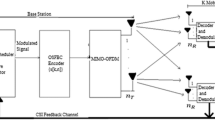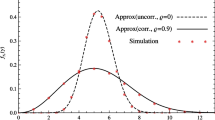Abstract
In this paper, we propose a novel approach for multiple input multiple output systems employing orthogonal space time block coding techniques considering independent but not necessarily identically distributed η–µ fading channels. We derive the probability density functions and cumulative distributions functions expressions for two different scenarios under (1) absolute SNR (AS) scheduling, and (2) threshold conditions. More specifically, under absolute SNR scheduling, PDF and CDF expressions are derived for independent non-identically distributed fading parameters, independent identically distributed average user SNRs (i.ni.d, i.i.d), and independent non-identically distributed fading parameters, and independent non-identically distributed average user SNRs (i.ni.d, i.ni.d). The derived expressions for PDF and CDF are used in obtaining average bit error rate and average channel capacity expressions for the proposed system. Both analytical and numerical results are shown to validate the obtained mathematical expressions.







Similar content being viewed by others
References
Spencer, Q. H., Peel, C. B., Swindlehurst, A. L., & Haardt, M. (2004). An introduction to the multi-user MIMO downlink. IEEE Communication Magazine, 42(10), 60–67.
Jindal, N. (2006). MIMO broadcast channels with finite-rate feedback. IEEE Transactions on Information Theory, 52(11), 5045–5060.
Bliss, D. W., Chan, A. M., & Chang, N. B. (2004). MIMO wireless communication channel phenomenology. IEEE Transactions on Antenna Propagation, 52(8), 2073–2082.
Dong, X., Jian-Kang, Z., Dumitrescu, S., & Feng-Kui, G. (2012). Full diversity non-coherent alamouti-based toeplitz space-time block codes. IEEE Transactions on Signal Processing, 60(10), 5241–5253.
Sameru, S., Sanjay, S., & Derick, E. (2012). MIMO system optimization using STTC based STBC with channel estimation. Wireless Personal Communications, 66(1), 147–165.
Yacoub, M. D. (2007). The κ–μ distribution and the η–μ distribution. IEEE Antennas and Propagation Magazine, 49(1), 68–81.
Serbetli, S., & Yener, A. (2004). Time slotted multiuser MIMO systems: Beamforming and scheduling strategies. EURASIP Journal on Wireless Communications and Networking, Special Issue on Multiuser MIMO Networks, 2004(2), 286–296.
Sigdel, S., & Krzymien, W. (2009). Simplified fair scheduling and antenna selection algorithms for multiuser MIMO orthogonal space-division multiplexing downlink. IEEE Transactions on Vehicular Technology, 58(3), 1329–1344.
Shen, Z., Chen, R., Andrews, J. G., Heath, R. W., & Evans, B. L. (2006). Low complexity user selection algorithms for multiuser MIMO systems with block diagonalization. IEEE Transactions on Signal Processing, 54(9), 3658–3663.
Perez, J., Ibanez, J., Via, Javier, & Santamarıa, I. (2009). Performance analysis of SNR-based scheduling policies in asymmetric broadcast ergodic fading channel. EURASIP Journal of Wireless Communications And Networking, 8, 1–6.
da Costa, D. B., Filho, J. C. S. S., Yacoub, M. D., & Fraidenraich, G. (2008). Second-order statistics of η–μ fading channels: Theory and applications. IEEE Transactions on Wireless Communications, 7(3), 819–824.
Peppas, K., Lazarakis, F., Alexandridis, A., & Dangakis, K. (2010). Cascaded generalized-K fading channel. IET Communications, 4(1), 116–124.
Papazafeiropoulos, A. K., & Kotsopoulos, S. A. (2012). Statistical properties for the envelope and phase of α−η−μ generalized fading channels. Wireless Personal Communications, 66(4), 651–666 (2012). http://link.springer.com/journal/11277/66/4/page/1.
Di Renzo, M., Graziosi, F., & Santucci, F. (2010). Channel capacity over generalized fading channels: A novel MGF-based approach for performance analysis and design of wireless communication systems. IEEE Transactions on Vehicular Technology, 59(1), 127–149.
Ermolova, N. Y. (2008). Moment generating functions of the generalized η–μ and κ–μ distributions and their applications to performance evaluations of communication systems. IEEE Communication Letters, 12(7), 502–504.
Ermolova, N. Y., & Tirkkonen, O. (2012). Outage probability over composite η–μ fading–shadowing radio channels. IET Communications, 6(13), 1898–1902.
Iong, J., & Chen, Z. (2007). A unified approach to average LCR and AFD performance of SC diversity in generalized fading environments. Journal of the Franklin Institute, 344(6), 889–911.
Hua, Y., Gang, W., Fei, J., & Zhang, X. (2011). On the error probability of cross-QAM with MRC reception over generalized η–μ fading channels. IEEE Transactions on Vehicular Technology, 60(6), 2631–2643.
Mark, J. O., Samir, B. B., & Saad, N. M. (2012). Capacity and error probability performance analysis for MIMO MC DS-CDMA system in η–μ fading environment. International Journal of Electronics and Communications (AEU), 67(4), 269–281.
Zhang, J., Matthaiou, M., Tan, Z., & Wang, H. (2012). Performance analysis of digital communication systems over composite η–μ/gamma fading channels. IEEE Transactions on Vehicular Technology, 61(7), 3114–3124.
Sang-Hyo, K., Jae-Dong, Y., & Jong-Seon, N. (2008). Exact bit error probability of orthogonal space-time block codes with quadrature amplitude modulation. Journal of Communications and Networks, 10(3), 253–257.
Gradshteyn, I. S., & Ryzhik, I. M. (2007). Table of integrals, series and products (7th ed.). California: Academic Press.
Huang, J., & Signell, S. (2009). On performance of adaptive modulation in MIMO systems using orthogonal space–time block codes. IEEE Transactions on Vehicular Technology, 58(8), 4238–4247.
Torabi, M., Haccoun, D., & Ajib, W. (2011). On the capacity and BER performance of multiuser scheduling over MIMO Nakagami-m fading channels. Signal Processing, 91(11), 2487–2496.
David, H. A., & Nagaraja, H. N. (2003). Order statistics (3rd ed.). London: Wiley.
Gaaloul, F., Radaydeh, R. M., Alouini, M. S., & Yang, H. C. (2012). On the performance of multiuser scheduling with post-examining under non-identical fading. In IEEE conference on wireless communications and networking, Shanghai, China (pp. 1251–1256).
Goldsmith, A. J., & Chua, S. G. (1997). Variable-rate variable-power MQAM for fading channels. IEEE Transactions on Communications, 45(10), 1218–1230.
Simon, M. K., & Alouini, M. (2000). Digital communications over fading channels: A unified approach to performance analysis (2nd ed.). London: Wiley.
Lee, H.-J. (2007). Wireless systems incorporating full-diversity single-symbol decodable space–time block codes. In Performance evaluation and development, ProQuest.
Author information
Authors and Affiliations
Corresponding author
Rights and permissions
About this article
Cite this article
Krithiga, S., Bhaskar, V. & Malarvizhi, S. Average Channel Capacity and Bit Error Rate Using Threshold Conditions for MIMO-OSTBC Systems Over η–µ Fading Channels. Wireless Pers Commun 94, 949–967 (2017). https://doi.org/10.1007/s11277-016-3659-0
Published:
Issue Date:
DOI: https://doi.org/10.1007/s11277-016-3659-0




